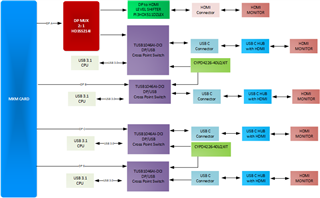Tool/software:
Hello,
the figure below shows a working solution in our hardware from a GPU (MXM CARD) to 4 x USB Type C connectors and one HDMI. There are two TI ICs associated.
TUSB1046AI-DCI - Cross Point Switch
HD3SS214I - DP MUX
For a new application, the GPU might changes and the interface may change from DP to DP++. Will that affect anything here or still continue to work as shown?
I would like a solution where if I change the GPU then whether it is DP or DP++ it continues to work as shown below.


